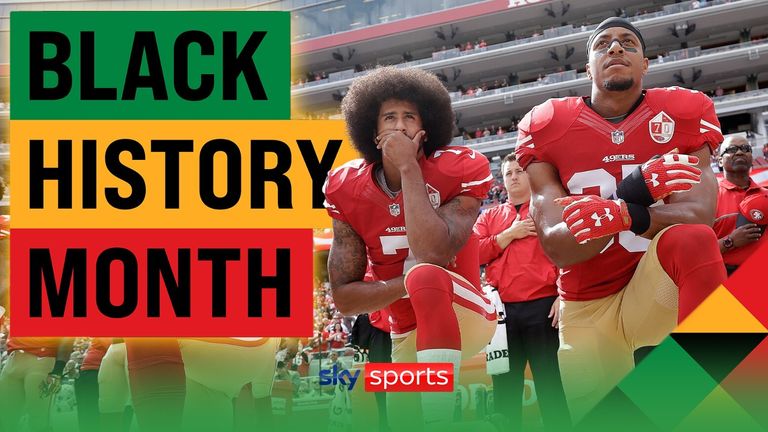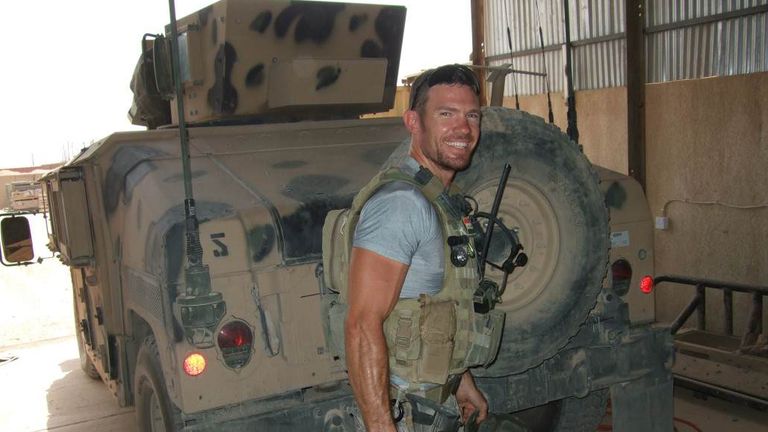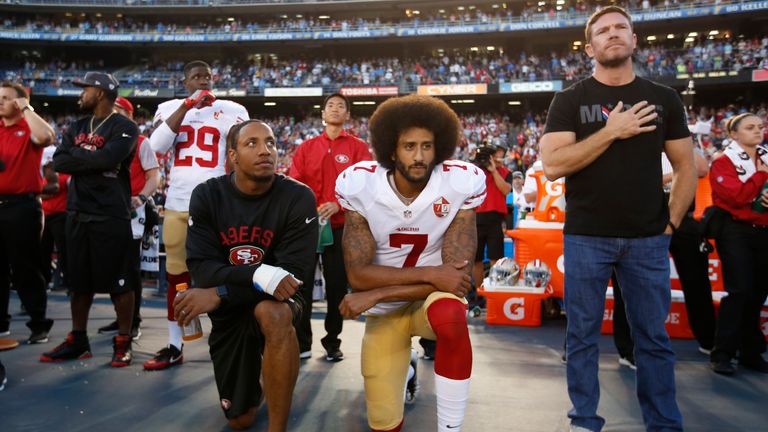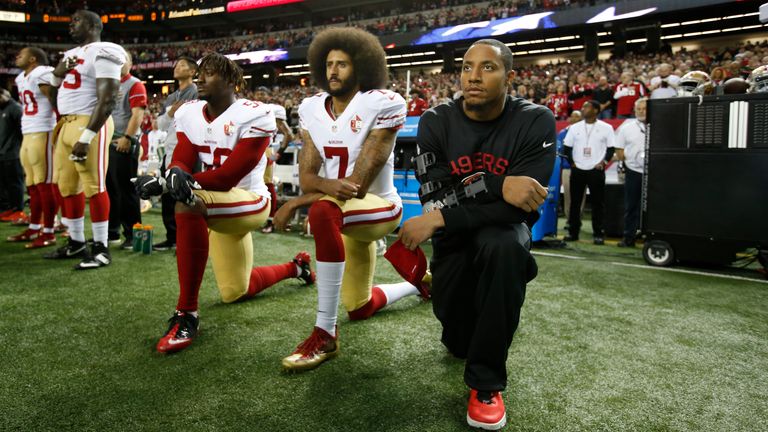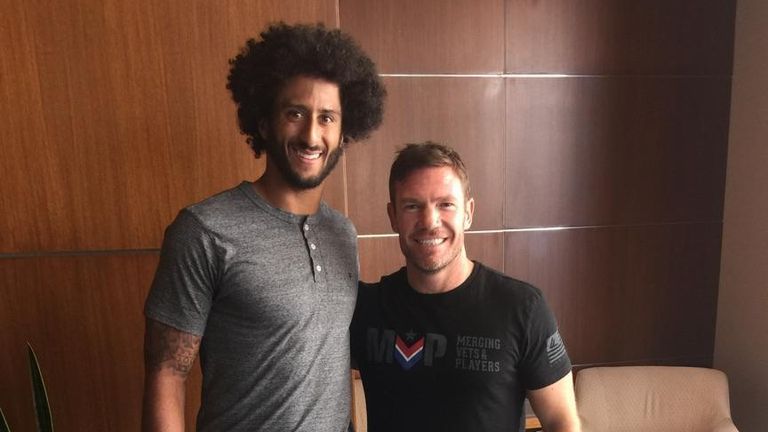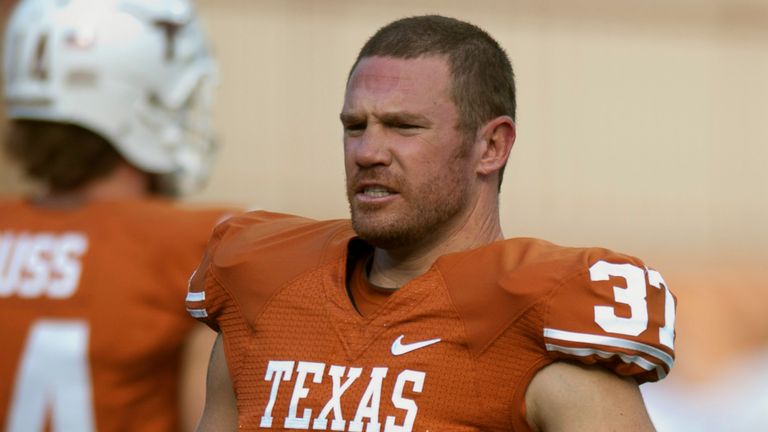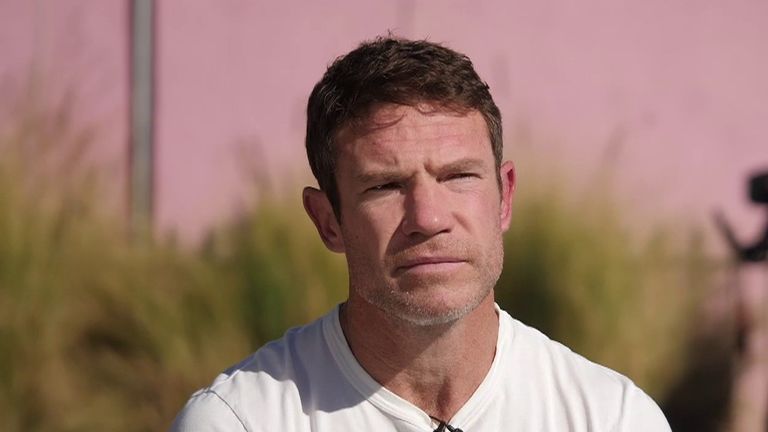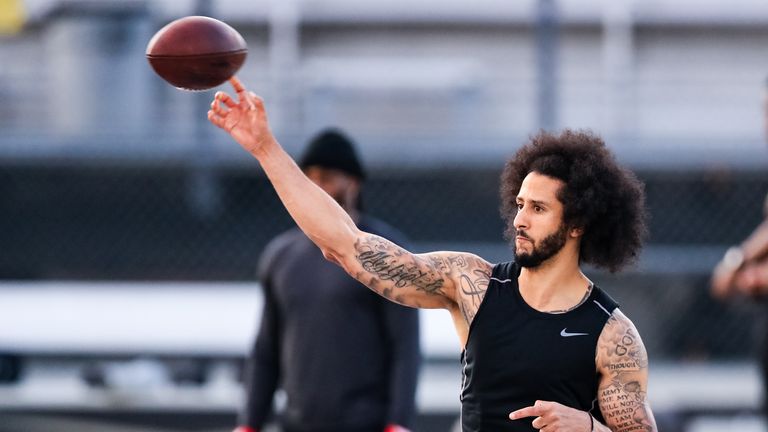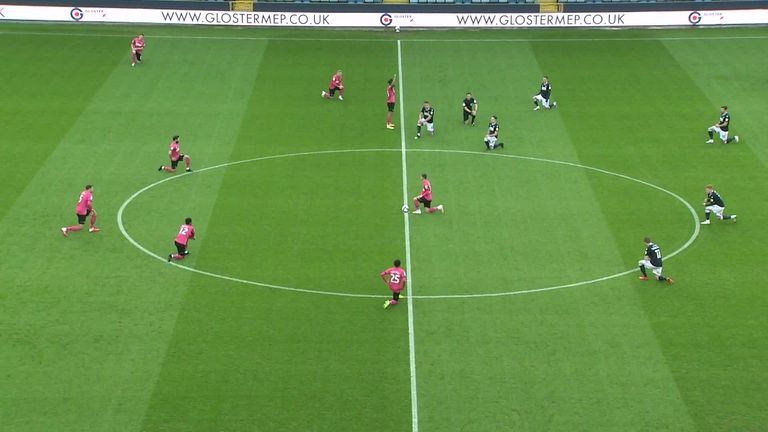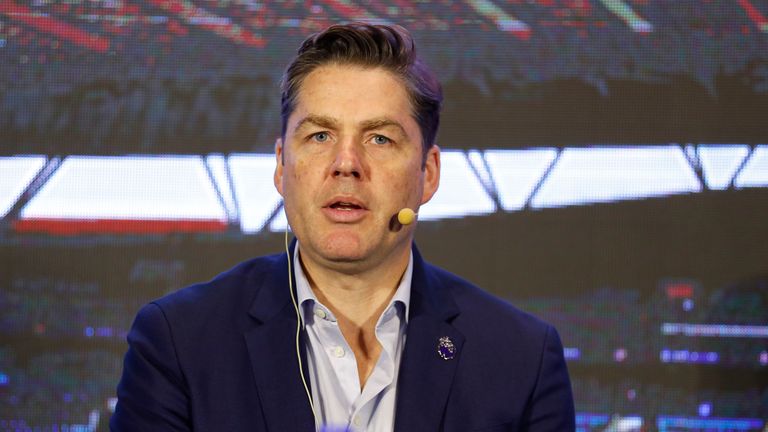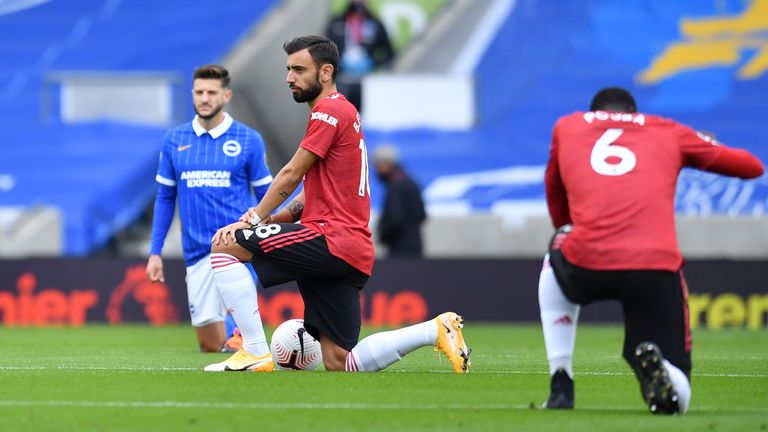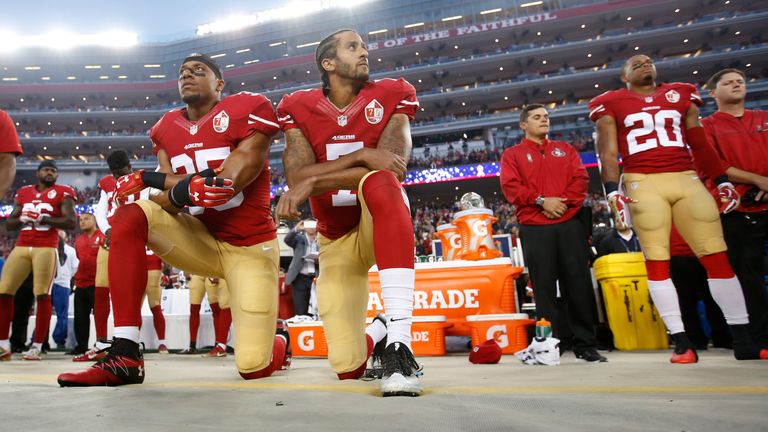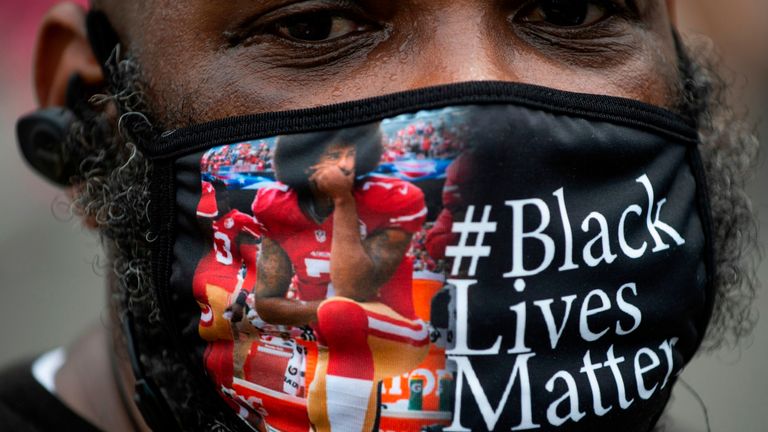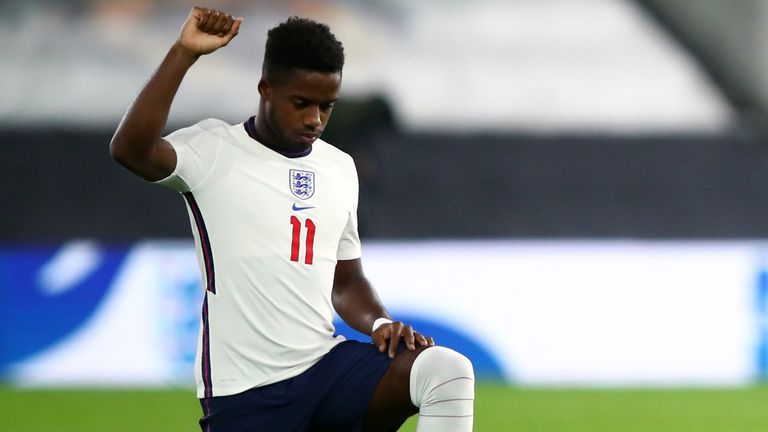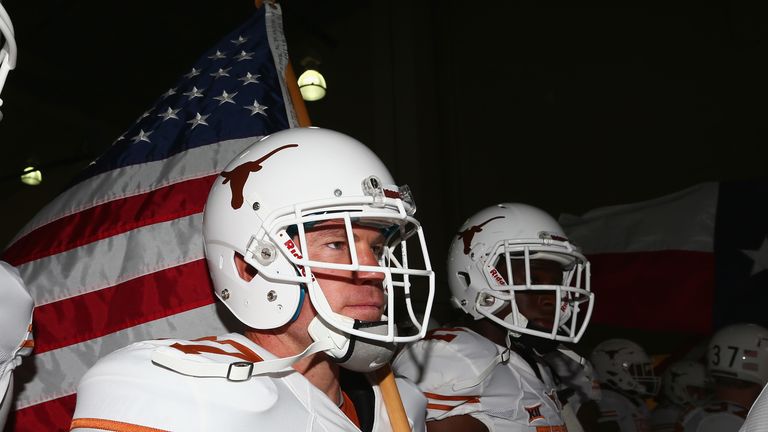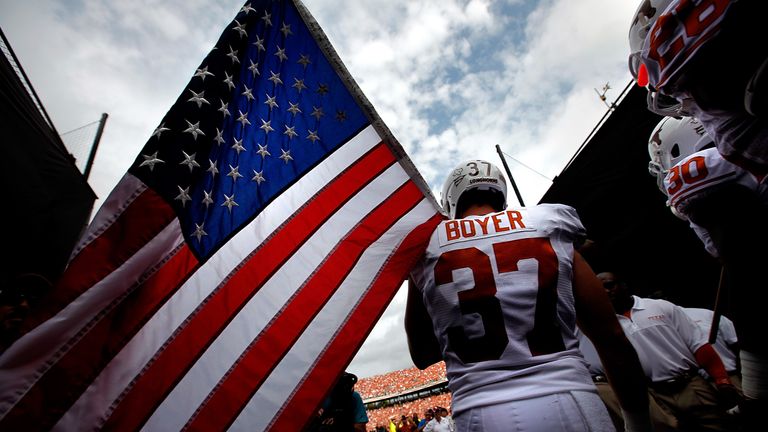Colin Kaepernick: How taking a knee started after NFL quarterback met Nate Boyer
Ex-soldier wrote open letter to Colin Kaepernick, who sat during national anthem; the quarterback requested meeting with Nate Boyer, who told him taking a knee was more respectful; Boyer on fans booing players in England: "It's sad... why can't you just respect somebody's opinion?"
Wednesday 30 December 2020 16:06, UK
Former special forces soldier Nate Boyer - who inspired Colin Kaepernick to start taking a knee - tells Sky Sports News the inside story of meeting the quarterback, what the gesture means, why it spread around the world, and his sadness at some fans booing football players in England.
When Colin Kaepernick decided in August 2016 to sit down during the national anthem at an NFL preseason game between the San Francisco 49ers and the Green Bay Packers, it divided the sport and people across the United States.
Kaepernick had actually sat for several games but this time it was both widely reported and criticised as the quarterback was in uniform and was about to take to the field for the first time in 10 months.
Former Green Beret Nate Boyer - who was a 49ers fan and long snapper with the Seattle Seahawks, after becoming the NFL's oldest rookie at the age of 34 - was among those who were upset.
An army veteran, who had witnessed the atrocities of the conflict in Darfur in 2004 before going on to tour Iraq and Afghanistan, Boyer was instrumental in Kaepernick's decision to go from sitting to taking a knee.
"When I saw Colin sitting on the bench during the national anthem and I read a headline and saw some pictures, I made a snap judgement based on my experiences," Boyer told Sky correspondent Greg Milam in Los Angeles.
"My relationship with the American flag, with the national anthem - those things are very special to me, because I've served in the military and I've carried a casket draped in an American flag with my best friend in it. I'm going to have a different feeling about those colours and when that flag is raised.
"Even though I was a huge 49ers fan and a Colin Kaepernick fan, I was disappointed. But I wasn't listening to what he was talking about.
"When I went back and actually listened to his first full 18-minute interview in the locker room and heard about why he was doing what he was doing, but also that he had a respect for the military and it wasn't about the military in any way, [I realised] it wasn't even really about the flag or the anthem.
"I changed my tune and I listened and tried to understand, and that's what prompted me to write that open letter."
Kaepernick and Boyer: The first meeting
After dozens of media requests because of his NFL and military background, Boyer wrote an open letter to Kaepernick in the Army Times on August 30, 2016.
In the letter, he admitted he had been angry at Kaepernick sitting down during "The Star Spangled Banner" but that he respected the player's right to protest.
He also wrote overcoming racism in the US would be a "slow process" and explained why the national anthem meant so much to him. The letter got much more attention than Boyer expected and within days, Kaepernick's publicist rang him.
"Colin reaching out after he read the open letter, it really did a lot for me. It helped me understand that he cared enough to listen as well. It's very important - you want people to listen to you, you've got to listen to them," he said.
"We didn't even have opposing opinions necessarily. We just had opposing experiences, opposing emotions, opposing reactions to what people say, what happens in this country. The flag, the anthem itself, the symbols of America based on what we've seen and done in life.
"When he reached out and wanted to meet and just talk, at first I was a little nervous because I thought, is this a publicity stunt? Why's he doing this? Is he going to use the fact that I'm a soldier and say, 'oh look, the military supports me because this one guy does'?
"I had those fears and concerns but I thought it was important to just go for it, go have a conversation - see what happens."
After a three-hour taxi ride, Boyer was in San Diego for the San Francisco 49ers' final preseason game in 2016.
"We met in the lobby of the team hotel four hours before kick-off. We sat down for a couple of hours and just talked," said Boyer, as he talked in detail about the inside story of the pair's first meeting.
"He knew a little bit about my story, I knew a little bit about his. He's a much better athlete than I am! We talked like two people... face to face.
"I could tell we were both nervous, I was nervous, he was nervous but a good type of nervous where it was curious and genuinely concerned with how people are going to react to what we're saying, what we're doing, trying to do the right thing, trying to be inclusive and make sure that everyone understands the message.
"He asked a lot of questions of me, I asked a lot of questions of him. Like why? And what? And how? I showed him messages from veterans I served alongside, or guys that I knew from the veteran community that adamantly disagreed with me even going to meet him. Or me even writing that open letter."
'I suggested taking a knee to Kaepernick...'
Boyer revealed the reaction to the letter polarised opinion. Some Green Berets who served with him called him a disgrace to the US army, which he admits hurt him.
Boyer showed Kaepernick those comments.
"He looked at those messages and he didn't become angry or anything, he just said they have their right to feel that way just as I have my right to say what I'm saying. I'm like, 'absolutely'," Boyer explained.
"After the end of these conversations is sort of when he asked me the toughest question. I didn't know this was coming and I was not prepared for it but he asked me: 'Do you think there's another way I can protest or demonstrate that's not going to offend people in the military?'
"And I said no! There's nothing you can do that's not going to offend people in the military.
"The military is the most diverse microcosm in America, I think. There's 20m of us - there's a ton of veterans in this country. We come from all walks of life, all shapes and sizes, colours, political beliefs, religious beliefs. People have this misconception that because we all do everything in uniform when it comes to a mission overseas that we all think the same. It's absolutely not true.
"I thought about it for a minute and I said, 'look, there's nothing you can do.' There's no gesture here that's going to be perfect. And ironically if you choose to just stop sitting on the bench and all of a sudden you're standing for the anthem, there's going to be a whole lot of people that are very upset that you didn't stick to your guns and you didn't see this thing through just because there was a big reaction.
"I said being alongside your team-mates is the most important thing. Whatever that looks like. You go out on that field, you play with those guys. You're shoulder to shoulder trying to complete a task, complete a mission - win the game.
"I think it's a great lesson for the country, for the world to see. They know when they see those 11 guys on the field, they don't all think the same and believe the same things. You watch a team play and in those moments for at least three hours, they put that stuff aside. Same with the fans in the stands.
"The guy sitting next to you could spill beer on you in the first quarter and you're like hugging him in the fourth quarter because your team scored the winning touchdown.
"So if you're alongside your team-mates, that would be a great thing for people to see.
"And I said if you're committed to not standing - which he said he was - I think the only logical solution or gesture, in my opinion, would be to take a knee.
"He thought it was actually more powerful than sitting. He kind of said right then and there, 'that's what I'm going to do'.
"He actually asked if I would take a knee with him. I said I wouldn't. I respect him doing that and I would stand next to him if he did that.
- Colin Kaepernick: Free agent says he is fit and ready to play
- Colin Kaepernick accuses NFL of 'blackballing' Eric Reid
- LeBron James: Colin Kaepernick owed an apology by NFL
"The feelings that I have when I see that flag and hear that song and the hope that I know it instils in a lot of people worldwide - I choose to stand for that reason and there's nothing wrong with that. Just because I stand when the anthem's played, it doesn't mean I don't think Black Lives Matter."
'Standing next to Colin, the boos shocked me'
Within hours, Boyer was standing next to Kaepernick as the player took a knee for the first time, alongside team-mate Eric Reid.
Former Staff Sergeant Boyer described the moment at the San Diego Chargers' Qualcomm stadium.
"Going out there before the game, I remember thinking, 'OK, he's making a significant adjustment'. He's willing to give quite a bit. I have a feeling most of the country will accept that. People that didn't support him would at least accept that as like, 'OK, at least he's trying to do something better'," Boyer said.
"The anthem started playing and he's standing next to his team-mates and he takes the knee as soon as the anthem starts and I'm standing there with my hand on my heart. And the amount of boos that I heard. It drowned out quite a bit of the singing. I was shocked in that moment.
"There's images of me with my left hand in my pocket. And it's purely out of nerves because typically when we stand for the anthem - whether you're in the military or not - you don't put your hand in your pocket.
"I just felt this 'uncomfortability' that I can't image what Colin actually felt. And what anybody who takes a knee feels. Because they know it's directed at them, versus I knew it was directed at the person next to me and not me. And that still made me feel uncomfortable."
For Boyer, it was a remarkable place to be alongside one of his sporting idols. The closest he had gotten previously was an autographed football from Kaepernick where he had also written "God Bless Our Troops".
Booing footballers kneeling is 'a sign of hate and anger'
When the Premier League resumed last season after the coronavirus restrictions, every team and player sent a powerful message by taking a knee.
Aston Villa and Sheffield United began the restart showing their support for the Black Lives Matter movement by taking a knee at kick-off for 10 seconds. Manchester City star Raheem Sterling described it as a "massive step".
Although it still continues in the Premier League, some EFL clubs decided to stop taking a knee and there have been boos at some games by the returning fans.
A section of home fans booed players as players took a knee between Millwall and Derby at the New Den. The club said they were dismayed and saddened at the events and said the players would not take a knee again, but will stand arm-in-arm in a "show of solidarity for football's fight against discrimination."
Cambridge United banned a section of the fans who booed players taking a knee while Colchester United chairman Robbie Cowling said fans who wanted to boo were not welcome, after a number of them booed players before a home match.
Boyer criticised football fans in England for booing players who kneel in support of the anti-racism campaign.
"It's not surprising, it's sad," he said.
"Why can't you just respect somebody's opinion? How is that not more disrespectful to yell out a boo over what somebody else is doing when it is supposed to be a moment of silent reflection? There's just so much hate in the world and anger.
"When I hear a boo, that's just when you absolutely dislike something, that's when you boo. I think it's way more disrespectful than anybody ever kneeling, or sitting for that matter.
"Taking a knee has never been in my experience seen as a disrespectful act. People take a knee to pray, to propose to a future spouse. When someone's knighted, they take a knee. When I visit Arlington (National Cemetery) and my buddy who's passed, I take a knee in front of his grave to pay respects.
"When a player's hurt on the field in a [US] football game, and probably a lot of sports, a lot of the other players will often take a knee out of respect until that player that's injured is either carted off, carried off, or walks off on their own.
"It's a respectful gesture. I also saw it like a flag being at half-mast in a way. We raise flags at half-mast when somebody passes away or we are remembering a dark day in our history."
Taking a knee after George Floyd's death
Boyer said the reaction to taking the knee in 2016 was bigger than he expected, and explained why its impact in 2020 is markedly different following the killing of unarmed black man George Floyd in police custody in Minneapolis in May.
"In the middle of this pandemic and this election cycle, there was so much on the edge that was bubbling just under the surface and that broke the ground and everything just released at once," he said.
"There was so much frustration in this world, people had just kind of had it. When that [Floyd's death] happened, everyone could see it. Even people that were pretty staunch adversaries to [the] social justice movement and thought that everything was pretty equal in our country.
- Roger Goodell wishes NFL had 'listened to Colin Kaepernick sooner' over protests
- Donald Trump would love to see Colin Kaepernick in NFL if good enough
- US election: Sport's unprecedented impact
"Anybody that watches that, if you don't have a gut reaction that tears you apart, I think you're missing something as a human being. It opened a lot of eyes and it changed a lot of tunes. There were people that spoke up that never had or at least listened that hadn't before."
Kneeling spread across the world as a way of protesting against racial injustice and oppression against black people.
As someone who inspired taking a knee in 2016, what does Boyer think?
"It's honestly become more global this year than it did four years ago," Boyer said.
"But even then, the reaction was way larger than I thought. It didn't hurt that it was the middle of a very decisive election cycle much like this year. At that time, it was Hillary Clinton versus Donald Trump.
"We had been seemingly pulled apart as a country for quite some time and this feeling of like you've got to take a side, pick a team, was pretty prevalent. I guess I wasn't surprised, it just was very eye-opening to be in the middle of that.
"I've never been a political person. All of a sudden, it's like within a day I became a poster boy for a lot of different things. So did Colin, in a much larger scale than I did. So that was very bizarre.
"Looking back, especially after this year, I wouldn't change anything I did or said. At first, I considered that, I was nervous of that because of the reaction - a lot of it negative from both sides.
"Some people thought, why are you messing with Colin's message? Like it was perfect the way it was, let him sit. Let him do his thing. I was like, 'I'm not trying to intervene.'
"I didn't tell him to protest, I didn't tell him to do anything. We just had a conversation. He asked questions and I answered them and vice-versa. I've got nothing but respect for him as a human being.
"There's still things today that he does and says that I don't necessarily agree with but that's OK. You can still have love for your fellow man as long as they're not out there doing physical harm to people.
"It's an important distinction. I would do it with my own family. With my brother and sister and my parents - we don't agree on everything, and we still can get through that."
Nate Boyer: Green Beret, college football, NFL, and charity
In his own words, Nate Boyer didn't have a lot of self-confidence growing up and says he wasn't a great athlete.
It was relief work in Darfur during a genocide in 2004 that inspired him to join the US military and eventually become a Green Beret.
"I gained my patriotism there for what we have here and the opportunities that we have and the potential that we have," he said.
"I believed in that potential and that is why I not only fought for this country, but fought for those people who could not fight for themselves like Iraq and Afghanistan."
Boyer says his military skills helped him to achieve "his crazy American dream" of finally playing college football at the age of 29.
He went to the University of Texas and tried out for the football team, making it onto the field as a long snapper. It is a position Boyer describes as "sort of an odd position" that often feels thankless.
He honed his skills by watching YouTube videos and practicing in the desert while deployed in Afghanistan as part of the National Guard.
It worked as he started 38 consecutive games for the Texas Longhorns.
"I worked my butt off to win that starting spot. I started for three years and then had an opportunity at 34 years old with the Seattle Seahawks," he said.
Boyer signed as a free agent with the Seahawks in May 2015 and played one preseason game against the Denver Broncos. He played five snaps and was praised by Seahawks head coach Pete Carroll but it was his only game as he was released in August.
"I was the oldest player on the team, the oldest rookie in NFL history and I had never even played football until five years before that.
"I know I wouldn't have had a hope in hell of playing football if I didn't serve my country, especially as a Green Beret. I think that had a lot to do with it."
Recently, Boyer has worked as a film and TV producer and actor. And using his experience as a former athlete and military veteran, he co-founded his own charity Merging Vets and Players (MVP).
It helps combat veterans and ex-professional athletes "once the uniform comes off" by empowering them, helping them transition into the next stage of their lives, and supporting their personal development.
Boyer said: "Now I'm just trying to be a good person and continue to chase my dreams while doing good for others and bringing this country together as much as possible."
Sky Sports NFL is your dedicated channel for NFL coverage through the season - featuring a host of NFL Network programming, a new weekly preview show as well as at least five games a week and NFL Redzone, you won't miss a moment. Don't forget to follow us on skysports.com/nfl, our Twitter account @SkySportsNFL & Sky Sports - on the go!
